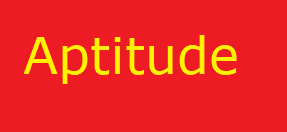Compound Interest – Aptitude Questions and Answers | Online Compound Interest MCQ Aptitude Test
| Quiz Name | Compound Interest |
| Category | Online Aptitude Test |
| Number of Questions | 30 |
| Time | 30 Minutes |
| Exam Type | MCQ (Multiple Choice Questions) |
1. A bank provides a 5% compound interest rate computed every half-year. On the first of January and the first of July of each year, a client deposits Rs. 1600. The amount he would have gained in interest at the end of the year is:
a. Rs. 120
b. Rs. 121
c. Rs. 122
d. Rs. 123
2. The difference between simple and compound yearly interest compounded on a specific quantity of money for two years at a rate of 4% per annum is Rs. 1.
a. 625
b. 630
c. 640
d. 650
3. A six-year period results in a 60 percent rise in a sum at simple interest. After three years at the same rate, what would the compound interest on Rs. 12,000 be?
a. Rs. 2160
b. Rs. 3120
c. Rs. 3972
d. Rs. 6240
4. What is the difference between compound interest on Rs. 5000 compounded yearly and half-yearly for 1 year at 4% per annum?
a. Rs. 2.04
b. Rs. 3.06
c. Rs. 4.80
d. Rs. 8.30
5. At a rate of 7% per year, the compound interest on Rs. 30,000 is Rs. 4347. The time frame is as follows (in years):
a. 2
b. 2 1/2
c. 3
d. 4
6. At a rate of 12 percent per annum, what will be the compound interest on an amount of Rs. 25,000 after three years?
a. Rs. 9000.30
b. Rs. 9720
c. Rs. 10123.20
d. Rs. 10483.20
7. In two years, at what rate of compound interest would an amount of Rs. 1200 become Rs. 1348.32?
a. 6%
b. 6.5%
c. 7%
d. 7.5%
8. The shortest period of time in which a quantity of money invested at 20% compound interest will be more than doubled is:
a. 3
b. 4
c. 5
d. 6
9. Albert put Rs. 8000 into a two-year fixed deposit programme with a compound interest rate of 5% per annum. When Albert’s fixed deposit matures, how much money will he receive?
a. Rs. 8600
b. Rs. 8620
c. Rs. 8820
d. None of these
10. The effective annual rate of interest, which corresponds to a nominal rate of 6% per annum and is paid half-yearly, is:
a. 6.06%
b. 6.07%
c. 6.08%
d. 6.09%
11. Simple interest on an amount of money for three years at an annual rate of 8% is half the compound interest on Rs. 4000 for two years at a rate of 10%. The amount set aside for simple interest is:
a. Rs. 1550
b. Rs. 1650
c. Rs. 1750
d. Rs. 2000
12. If the simple interest on a quantity of money is Rs. 50 after two years at 5% per annum, what is the compound interest at the same rate and for the same period?
a. Rs. 51.25
b. Rs. 52
c. Rs. 54.25
d. Rs. 60
13. The difference between simple and compound interest on Rs. 1200 for a year at a rate of 10% per annum calculated half-yearly is:
a. Rs. 2.50
b. Rs. 3
c. Rs. 3.75
d. Rs. 4
14.On a sum of Rs. 15,000 over two years, the difference between compound and simple interest is Rs. 96. How much does it cost to borrow money and how much does it cost to borrow money?
a. 8
b. 10
c. 12
d. Cannot be determined
15. At a rate of 10% per year, the compound interest on a specific money for two years is Rs. 525. The simple interest on the same money over double the period at half the annual rate is:
a. Rs. 400
b. Rs. 500
c. Rs. 600
d. Rs. 800
16. What is the compound interest rate?
I. The first investment was made for a period of four years.
II. The interest earned was Rs. 1491.
a. I alone sufficient while II alone not sufficient to answer
b. II alone sufficient while I alone not sufficient to answer
c. Either I or II alone sufficient to answer
d. Both I and II are not sufficient to answer
17. How much will be compounded?
I. Rs. 200 was borrowed for 192 months at a compounded annual interest rate of 6%.
II. A loan of Rs. 200 was taken out for 16 years at a rate of 6%.
a. I alone sufficient while II alone not sufficient to answer
b. II alone sufficient while I alone not sufficient to answer
c. Either I or II alone sufficient to answer
d. Both I and II are not sufficient to answer
18. A sum of money was lent for a period of three years. What is the difference between simple and compound interest collected on the same amount of money? The point of interest was 8 p.c.p.a. Simple interest amounted to Rs. 1200 in total.
a. I alone sufficient while II alone not sufficient to answer
b. II alone sufficient while I alone not sufficient to answer
c. Either I or II alone sufficient to answer
d. Both I and II are necessary to answer
19. What is the p.c.p.a. rate of interest?
I.On simple interest, a sum doubles after 5 years.
II.The difference between compound and simple interest generated on a given sum over two years is Rs. 400.
III.The annual simple interest received is Rs. 2000.
a. I only
b. II and III only
c. All I, II and III
d. I only or II and III only
20. In two years, what would be the compound interest on a sum of Rs. 5000?
I. In 5 years, the simple interest on the same money at the same rate is Rs. 2000.
II. The simple and compound interest earned in one year are the same.
III. In ten years, the sum had more than doubled due to compound interest.
a. I only
b. I and II only
c. II and III only
d. I and III only
21. Mr. Gupta took out a loan with compound interest. What would be the repayment amount if he repays the whole amount at the conclusion of the two-year period?
I. The interest rate is 5% per annum.
II. One year’s simple interest on the same money is Rs. 600.
III. In two years, the amount borrowed is 10 times the basic interest.
a. I only
b. I and II only
c. II and III only
d. I and III only
22. What is the amount of compound interest received after three years?
I. The simple interest received at the same rate and for the same term on that amount is Rs. 4500.
II. The interest rate is ten percent each annum.
III. For a period of three years, compound interest is Rs. 465 more than simple interest.
a. I only
b. I and II only
c. II and III only
d. I and III only




